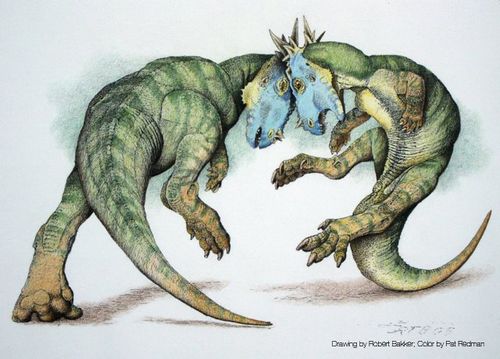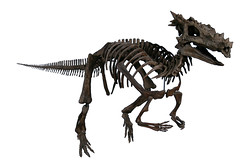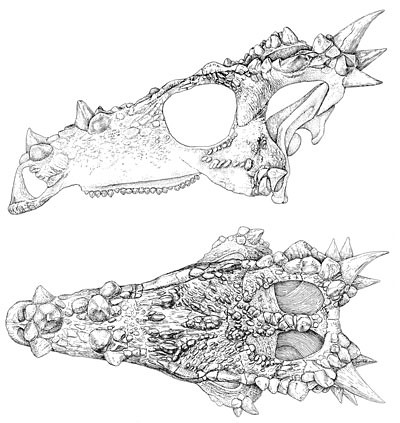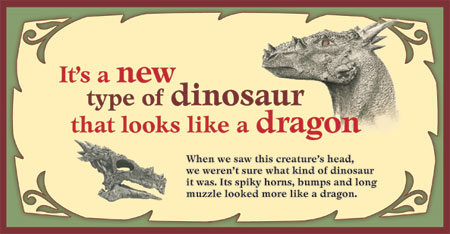tags: dinosaur, fossil, Children's Museum of Indianapolis, pachycephalosaur, Dracorex hogwartsia, Harry Potter
.

Dracorex hogwartsia,
a newly discovered member of the pachycephalosaur family of dinosaurs.
Image: Drawing by paleontologist Robert Bakker, provided by the Children's Museum of Indianapolis.
It was only a few years ago when JK Rowling was just another single mother who was on the dole, sitting in a coffee shop, scribbling stories on napkins and spare pieces of paper, and now, she is the richest woman in the UK and has a dinosaur named in honor of her imaginary world. Heyyy, waitaminit, you say. What's this BS? A dinosaur?
Yes, indeed! A newly discovered 66-million-year-old skull from a new dinosaur species was named after Hogwarts School of Witchcraft and Wizardry, made famous in JK Rowling's Harry Potter series. This nearly complete skull, from a creature named Dracorex hogwartsia, now has a permanent home in the Children's Museum of Indianapolis, announced paleontologist Robert Bakker.
 The 10-foot-long herbivore was recreated and publically displayed as scientists think it looked by mounting the skull on the skeleton of a closely related pachycephalosaurus (pictured, click image for MUCH larger view in its own window). Children who visited the museum said the skeleton looked like a dragon. Robert T. Bakker, a national dinosaur expert and consultant to The Children's Museum, took that into account when deciding on its name.
The 10-foot-long herbivore was recreated and publically displayed as scientists think it looked by mounting the skull on the skeleton of a closely related pachycephalosaurus (pictured, click image for MUCH larger view in its own window). Children who visited the museum said the skeleton looked like a dragon. Robert T. Bakker, a national dinosaur expert and consultant to The Children's Museum, took that into account when deciding on its name.
"The creature is a very special dinosaur that seems at home in a 'Harry Potter' adventure," explained Bakker. "It was a plant-eater, only about as heavy as the war horse of a medieval knight. And it carried an armor-plated head of almost magical configuration, covered with knobs and spikes, horns and crests. I was staring at the skull last summer, and the name just popped into my head, 'hogwartsia'."
The dinosaur's name was taken from the Latin words for dragon, draco, and king, rex, and the latinized name for Hogwarts, hogwartsia, the fictional school for witchcraft and wizardry made famous in J.K. Rowling's Harry Potter novels. When informed that the dinosaur had been named for her fictional school, Rowling wrote;
The naming of Dracorex hogwartsia is easily the most unexpected honour to have come my way since the publication of the Harry Potter books! I am absolutely thrilled to think that Hogwarts has made a small (claw?) mark upon the fascinating world of dinosaurs.
I happen to know more on the subject of paleontology than many might credit, because my eldest daughter was Utahraptor-obsessed and I am now living with a passionate Tyrannosaurus rex-lover, aged three.
My credibility has soared within my science-loving family, and I am very much looking forward to reading Dr. Bakker's paper describing 'my' dinosaur, which I can't help visualising as a slightly less pyromaniac Hungarian Horntail.
The Hungarian Horntail was the mythical dragon that Harry Potter faced in the Triwizard Contest described in Harry Potter and the Goblet of Fire. According to the book, the Hungarian Horntail was the most aggressive and unpredictable of all the dragon species.
Species names last forever, Bakker pointed out. No one can change a species name unless it was already named based on the formal description of a previously discovered specimen.
According to Bakker, "Honoring an author with a species name is rare. But it should be done more often. Art, literature and science are three ways of seeing reality and sharing our exploration of the world. From now on, anyone thinking about Bone-Head dinosaurs will cite the Type [Specimen] of Dracorex hogwartsia housed at The Children's Museum of Indianapolis."
Taxonomically speaking, every "Type Specimen" is unique because it is the one individual that represents and defines its entire species. Every species of animal and plant requires a "Type" -- the specimen that reveals how that species is different from every other species on earth. Once a Type is chosen, it cannot be shifted to any other specimen except under very unusual circumstances.
This dinosaur, a member of the pachycephalosaur family, has a flat skull with spiky horns, bumps and a long muzzle (see drawing above, by Robert Bakker). All other pachycephalosaurs described so far had domed foreheads.
Some scientists think the herbivorous pachycephalosaurs used their knobby heads to headbutt each other. However, since no complete neck bones from pachycephalosaurs had ever been found, conclusive evidence for headbutting was lacking. But in addition to this skull, preparators at the Children's Museum also pieced together four nearly complete neck vertebrae for Dracorex hogwartsia. They discovered that these vertebrae have special anti-twist joints and enlarged muscle attachments sites, suggesting that these dinosaurs did engage in violent head-banging contests.
The 18-inch-long skull was found in the famous Hell Creek Formation in central South Dakota by three Sioux City, Iowa residents; Steve Saulsbury, his brother Patrick, and their friend Brian Buckmeier. After discussing it between themselves, they unanimously agreed to donate the skull to the Children's Museum in late 2004, before it was named.
"When we found the skull, all that was showing was a little of the snout and some teeth," said Steve Saulsbury. "But as we excavated more of it, it was clear we had something unique."
The fossil skull was shipped to the children's museum, still encased in a protective layer of rock and mud. After it was received by the museum, it took two years for vertebrate paleontologist and fossil preparator, Victor Porter, to clean and reassemble it. Porter also made casts of the skull that were used by other scientists to confirm that this dinosaur was a new species.
"This is the first new dinosaur found, restored and named by a children's museum," said Bakker. He will join other officials for today's naming event, which will be streamed live on the web. [satellite video feed of the naming ceremony; TODAY at 3:15 - 3:30 pm EDT, feed provided by the Pennsylvania Satellite News Service].
The fossil will be formally unveiled today at 10am and will be displayed on the second level of the museum throughout the summer. It will then be moved to its permanent home in the museum's Dinosphere, which is devoted to exhibitions of dinosaur skeletons and bones.
Bakker, R. T., Sullivan, R. M., Porter, V., Larson, P. and Salsbury, S. J. 2006. Dracorex hogwartsia, n. gen., n. sp., a spiked, flat-headed pachycephalosaurid dinosaur from the Upper Cretaceous Hell Creek Formation of South Dakota. in Lucas, S. G. and Sullivan, R. M., eds., Late Cretaceous Vertebrates from the Western Interior. New Mexico Museum of Natural History and Science Bulletin 35, p. 331-345. [a target="window" href="http://www.childrensmuseum.org/dinosphere/draco_rex/dracorex_hogwartsia…">PDF]
- Log in to post comments



Of course, Draco is not just "dragon", it is also Draco Malfoy, who is a butt-head. How appropriate. I love it when species get names after people or cultural icons (like those three dung-beetles named after Bush, Cheney and Rumsfeld).
that is easily the coolest science/arts collaboration I have heard in a long time.
Also on this subject: here.
Hehe! I know that scientists have pretty free reign over naming their discoveries. But is taking names from pop culture all that common?
WOW! Now that is a great story! And the coolest dinosaur since T-Rex! thanks!
The three beetles are not dung beetles. Instead they eat slime molds.
Inexplicably, the biologists who named them insisted (at that time at least!) that they seriously meant it as an honor for those people who, you know, "stay the course" (on the Titanic). However, I still think it's actually a parody. I haven't seen any good evidence to the contrary so far. I mean, slime molds... The right pic on this page shows a slime mold creeping up a leaf, digesting it, and then dripping down. :-)
Taking names from pop culture is more common than most people think. Somewhere online there's a long list...
There is quite a history of scientific names being 'strange'. For example, check out the following site for the naming of fruit flies. Just about anything goes!
http://sciencereview.berkeley.edu/articles/issue2/flyname.pdf
You haven't seen silly till you read a list of Drosophila gene names.
Indeed there is:
Curiosities of Biological Nomenclature
Including Attenborosaurus (after David Attenborough),
and
Golfingia Lankaster, 1885 (Sipunculid) named "in honor of golf". Reportedly, it was discovered while two professors were golfing at St. Andrews. A ball was sliced and landed on a beach next to the unusual animal.
to pick a couple of examples at random.
Fun to explore.
All other pachycephalosaurs described so far had domed foreheads.
Actually, not so. A selected list of flat-headed pachycephalosaurs from the Bakker et. al paper:
Homalocephale calathocercos, Goyocephale lattimorei, Wannanosaurus yansiensis (all Asian) and the semi-flat-headed Stegoceras validum (North America).
What makes Dracorex interesting is that (a) it's truly flat-headed and from N. America (a first) and (b) it's a more recent genus than many of the domed pachycephalosaurs, which brings into question the previous hypothesis that flat heads evolved into domed heads.
I'd offer you a PDF, but I only have a hardcopy, sorry.
I don't know. Naming this after such a pop reference just because it looks like a dragon? It's not like the rest of the world didn't know about dragons before Harry Potter. One article I read elsewhere actually said, "Named after a fictional creature popularized by the Harry Potter books." I think that's just plain arrogant and incorrect. I don't think there's ever been an era (long before Harry Potter) when all children knew what a dragon was. Why not pick a more historically sound fantasy author, or one who actually wrote about dragons primarily? Tolkien features Smaug in The Hobbit over 50 years before Rowling, and Anne McCaffrey's Dragons are some of the most popular in Sci-Fi history. It just seems completely off-base to use Harry Potter, and especially to attribute any cultural significance of dragons to her books. They were culturally significant 50 years ago, 500 years ago, and in China, 5,000 years ago.
Lora, they didn't name the dinosaur to honor dragons--they named it to honor J.K. Rowling, specifically "in honor of her contribution to children's education and the joy of exploration," according to the paper.
I might quibble with her contribution to education (I've seen little evidence that kids who didn't read before Harry Potter read anything else after, but I'm sure there are librarians out there who know better than I), but it's not really about dragons. The press release quotes have the flavor of having been dragged out and possibly embellished by an overzealous PR writer, IMO.
Frankly, I'm disappointed that the press coverage has focused so much on "named after Harry Potter" and not on "wow, this totally changes our ideas about pachycephalosaur evolution!" C'est la vie, I guess.
I'd love to see someone write an article for a daily newspaper about the discovery of a flat-headed pachycephalosaur that wasn't named after something famous. It's a good trick for publicising an interesting discovery, that otherwise would have languished unnoticed in the New Mexico bulletin and gathering dust in the children's museum
"Draco" is a very beautiful name for such a beautiful dinosaur. X333
I can guarantee that nothing is "gathering dust" at The Children's Museum. The museum always seems to be changing & innovating. The original Dracorex specimen is currently on display. There are also plans to put the PDF of the NMMNHS "Dracorex" article on the museum's website. (That should happen pretty soon.) - The museum also encourages qualified researchers to work with its collection.
You can dowbload the PDF of the Dracorex hogwartsia scientific paper at http://www.childrensmuseum.org/dinosphere/draco_rex/index.html